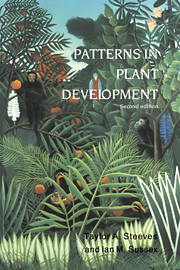Book contents
- Frontmatter
- Contents
- Preface
- Acknowledgments
- 1 Development in the vascular plants
- 2 Embryogenesis: beginnings of development
- 3 Analytical and experimental studies of embryo development
- 4 The structure of the shoot apex
- 5 Analytical studies of the shoot apex
- 6 Experimental investigations on the shoot apex
- 7 Organogenesis in the shoot: leaf origin and position
- 8 Organogenesis in the shoot: determination of leaves and branches
- 9 Organogenesis in the shoot: later stages of leaf development
- 10 Determinate shoots: thorns and flowers
- 11 The development of the shoot system
- 12 The root
- 13 Differentiation of the plant body: the origin of pattern
- 14 Differentiation of the plant body: the elaboration of pattern
- 15 Secondary growth: the vascular cambium
- 16 Secondary growth: experimental studies on the cambium
- 17 Alternative patterns of development
- Credits
- Author index
- Subject index
6 - Experimental investigations on the shoot apex
Published online by Cambridge University Press: 21 December 2009
- Frontmatter
- Contents
- Preface
- Acknowledgments
- 1 Development in the vascular plants
- 2 Embryogenesis: beginnings of development
- 3 Analytical and experimental studies of embryo development
- 4 The structure of the shoot apex
- 5 Analytical studies of the shoot apex
- 6 Experimental investigations on the shoot apex
- 7 Organogenesis in the shoot: leaf origin and position
- 8 Organogenesis in the shoot: determination of leaves and branches
- 9 Organogenesis in the shoot: later stages of leaf development
- 10 Determinate shoots: thorns and flowers
- 11 The development of the shoot system
- 12 The root
- 13 Differentiation of the plant body: the origin of pattern
- 14 Differentiation of the plant body: the elaboration of pattern
- 15 Secondary growth: the vascular cambium
- 16 Secondary growth: experimental studies on the cambium
- 17 Alternative patterns of development
- Credits
- Author index
- Subject index
Summary
Most of the work reviewed thus far has consisted of observations of various types of shoot apices that are for the most part normal or at least intact. It is also possible to investigate the organization of the meristem by subjecting it to experimental treatments and analyzing its reaction to these manipulations. The most widely used and the most successful of the experimental procedures applied to shoot apices has been microsurgery, in which delicate instruments are used to make punctures, incisions, and excisions in various regions of the meristem. Experiments of this sort have also been carried out in sterile culture so that the surgically isolated region of the meristem can be grown in isolation from the remainder of the plant. By these methods it is possible to obtain information about the roles played by various portions of the meristem and about interactions between parts of the meristem and between the meristem and other parts of the plant. One limitation of the surgical method is that it cannot be assumed that the effects of operations are just the isolation or removal of particular regions of meristematic tissue. Wounding may itself produce its own responses that are difficult to evaluate in terms of the normal apex, for example, cell proliferation. Thus, methods involving surgical manipulations tell a great deal about the potentialities of portions of a meristem, information that is extremely valuable, but experiments must be controlled carefully and the results screened rigorously if the information is to be applied validly to the interpretation of the organization of the intact meristem.
- Type
- Chapter
- Information
- Patterns in Plant Development , pp. 86 - 99Publisher: Cambridge University PressPrint publication year: 1989
- 2
- Cited by

